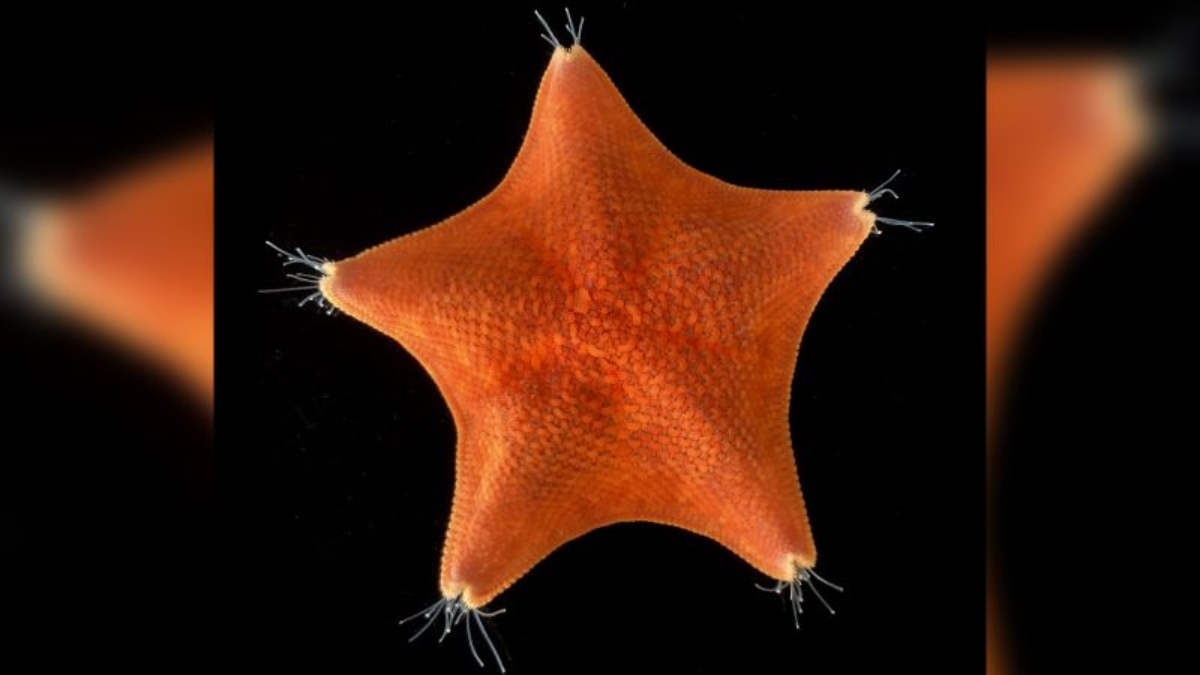(CNN) — The heads of most animals are easily recognizable, but until now scientists have been unable to say the same for starfish.
The starfish has five identical arms with a layer of “tube feet” underneath that help the sea creature move along the sea floor. This has led naturalists to wonder whether starfish have defined front and back ends, and whether they have a head.
But new genetic research suggests the opposite: that starfish are largely heads, lacking a trunk or tail, and likely lost those features evolutionarily over time. Researchers say strange fossils of starfish ancestors, which appear to have some sort of trunk, make more evolutionary sense according to the new findings.
The results were published on Wednesday in the journal nature.
“It is as if the starfish has lost its entire proboscis and is best described as a simple head dragging along the sea floor,” Laurent Formery, lead author of the study and a postdoctoral fellow at the University of Massachusetts, said in a statement. and University of California, Berkeley. “This is not at all what scientists assumed about these animals.”
These findings, made possible by new genetic sequencing methods, could help answer some of the key questions that still remain about echinoderms, including their common ancestry with humans and other animals that are nothing like them.
The body structure is unique
Starfish belong to the echinoderm group, which includes sea urchins, sand dollars (or sea biscuits), and sea cucumbers. These unusual animals have a single body, arranged in five equal sections, which differs greatly from the symmetrical bodies of bilateral animals, whose right and left sides are mirrored in each other.
Starfish start out as fertilized eggs that hatch into larvae that float in the ocean, like plankton, for weeks or months before settling on the seafloor. There they go through the process of transforming the binary body into a star-shaped, or pentagonal, body.
“This has been a mystery in zoology for centuries,” Christopher Lowe, co-lead author of the study and a marine and developmental biologist at Stanford University, said in a statement. “How do we go from a two-sided body plan to a five-sided body plan, and how does any part of a starfish compare to the body structure?”
The bilateral body structure of most animals comes from genetic actions at the molecular level that can be traced back to the head and trunk or main body regions, which is why vertebrates, such as humans, and many invertebrates, including insects, share similar genetic programming. This discovery won an award Nobel Prize in Physiology or Medicine In 1995.
However, echinoderms also share a common ancestor with bilaterian animals, adding to the mystery researchers are trying to solve.
“How the different body parts of echinoderms relate to those we see in other groups of animals has been a mystery to scientists ever since we studied them,” said Dr Geoff Thompson, co-author of the study and professor at the University of Southampton. “In their bilateral relatives, the body is divided into a head, trunk, and tail. But just by looking at a starfish, it is impossible to see how these divisions relate to the bodies of bilateral animals.”
Breaking the echinoderm code
In the new study, researchers used computed tomography to get an unprecedented 3D view of the shape and structure of starfish.
Next, team members used advanced analytical techniques to discover where genes are expressed within tissues and identify specific RNA sequences within cells. Gene expression occurs when information in a gene becomes active.
Specific molecular markers act as blueprints for the body, directing each cell to the area of the body to which it belongs.
“If you peel the skin off an animal and look at the genes that define the tip of the tail, the same genes encode these body regions in all groups of animals,” Lowe explains. “So we ignore the anatomy and ask: Is there a molecular axis hidden beneath all this strange anatomy and what is its role in the sea star’s formation of a pentagonal body structure?”
Shown here is the nervous system of a starfish during analysis. (Credit: Laurent Foreri)
Together, the data created a 3D map to determine where genes are expressed during sea star development and growth. The team was able to identify genes that control the development of the starfish’s ectoderm, which includes the skin and nervous system.
Gene signatures associated with head growth were detected in all sea stars, especially concentrated in the center of the star and in the center of each limb. However, gene expression for the trunk and tail segments was largely absent, revealing that the starfish “represents the most dramatic example of the separation of head and trunk regions that we know of today.” Zuckerberg BioHub, a nonprofit research organization in San Francisco.
The research was funded by the Chan Zuckerberg BioHub, co-founded in 2021 by Dr. Priscilla Chan and Mark Zuckerberg, as well as NASA, the National Science Foundation and the Leverhulme Fund.
The researchers stained the starfish’s genetic material with fluorescent markers, allowing scientists to map the behavior of these animals’ genes. (Credit: Laurent Foreri)
“When we compared starfish gene expression with gene expression in other animal groups, such as vertebrates, an important part of their body structure appeared to be missing,” Thompson explained. “The genes normally involved in the formation of the animal’s trunk are not expressed in the ectoderm. The entire body structure of echinoderms appears to be more or less equivalent to the structure of the head in other groups of animals.”
Starfish and other echinoderms likely developed their unique body structures once their ancestors lost the trunk region, which allowed them to move and feed differently from other animals.
“Our research tells us that the body structure of echinoderms evolved in a more complex way than previously thought, and that there is still a lot to learn about these interesting creatures,” Thompson said. “As someone who has studied these animals for the past 10 years, these findings have radically changed the way I think about this group of animals.”
New results
Research on animals focuses primarily on those that share similarities with humans. However, studying groups such as echinoderms could solve some of the most complex mysteries about the evolution of life on Earth.
“Most animals don’t have amazing nervous systems and go out chasing their prey: they are humble animals that live in burrows in the ocean. People are not generally attracted to these animals, yet they probably represent how most life began,” Lowe says.
Understanding how animals like starfish evolve can also provide insight into the different ways different species maintain their health.
“It’s certainly more difficult to work with organisms that are less frequently studied,” says Daniel Rukhsar, co-author of the study, professor of genetics, genomics, evolution, and development at UC Berkeley and a researcher at the Chan Zuckerberg BioHub. He said in a statement:
“But if we seize the opportunity to explore unusual animals that work in unusual ways, it means we are broadening our perspective on biology, which will ultimately help us solve environmental and biomedical problems.”

“Proud web fanatic. Subtly charming twitter geek. Reader. Internet trailblazer. Music buff.”



:quality(85)/cloudfront-us-east-1.images.arcpublishing.com/infobae/E3MFZXDKZJGKFAMKCA4KUTH3PE.jpg)



More Stories
The only human buried on the moon is an American
Five tricks to stop receiving spam emails
From this date, days on Earth will be 25 hours long